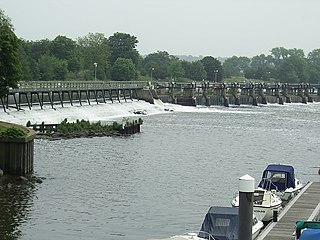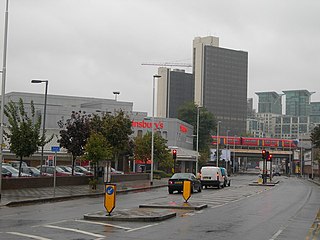
Lambeth is a district in South London, England, in the London Borough of Lambeth. Lambeth was an ancient parish in the county of Surrey. It is situated 1 mile (1.6 km) south of Charing Cross. The population of the London Borough of Lambeth was 303,086 in 2011. The area experienced some slight growth in the medieval period as part of the manor of Lambeth Palace. By the Victorian era the area had seen significant development as London expanded, with dense industrial, commercial and residential buildings located adjacent to one another. The changes brought by World War II altered much of the fabric of Lambeth. Subsequent development in the late 20th and early 21st centuries has seen an increase in the number of high-rise buildings. The area is home to the International Maritime Organization. Lambeth is home to one of the largest Portuguese-speaking communities in the UK, and Portuguese is the second most commonly spoken language in Lambeth after English.

Sir Joseph William Bazalgette CB was a British civil engineer. As Chief Engineer of London's Metropolitan Board of Works, his major achievement was the creation of a sewerage system for central London which was instrumental in relieving the city of cholera epidemics, while beginning to clean the River Thames. He later designed Hammersmith Bridge.

Lambeth Bridge is a road traffic and footbridge crossing the River Thames in an east–west direction in central London. The river flows north at the crossing point. Downstream, the next bridge is Westminster Bridge; upstream, the next bridge is Vauxhall Bridge.

Battersea Bridge is a five-span arch bridge with cast-iron girders and granite piers crossing the River Thames in London, England. It is situated on a sharp bend in the river, and links Battersea south of the river with Chelsea to the north. The bridge replaced a ferry service that had operated near the site since at least the middle of the 16th century.

Victoria Embankment is part of the Thames Embankment, a road and river-walk along the north bank of the River Thames in London, England. Built in the 1860s, it runs from the Palace of Westminster to Blackfriars Bridge in the City of London, and acts as a major thoroughfare for road traffic between the City of Westminster and the City of London.

The Thames Embankment is a work of 19th-century civil engineering that reclaimed marshy land next to the River Thames in central London. It consists of the Victoria Embankment and Chelsea Embankment.

A Yablochkov candle is a type of electric carbon arc lamp, invented in 1876 by the Russian electrical engineer Pavel Yablochkov.

Chelsea Bridge is a bridge over the River Thames in west London, connecting Chelsea on the north bank to Battersea on the south bank, and split between the City of Westminster, the London Borough of Wandsworth and the Royal Borough of Kensington and Chelsea. There have been two Chelsea Bridges, on the site of what was an ancient ford.

Albert Bridge is a road bridge over the River Thames connecting Chelsea in Central London on the north bank to Battersea on the south. Designed and built by Rowland Mason Ordish in 1873 as an Ordish–Lefeuvre system modified cable-stayed bridge, it proved to be structurally unsound, so between 1884 and 1887 Sir Joseph Bazalgette incorporated some of the design elements of a suspension bridge. In 1973 the Greater London Council added two concrete piers, which transformed the central span into a simple beam bridge. As a result, today the bridge is an unusual hybrid of three different design styles. It is an English Heritage Grade II* listed building.

The Great Stink was an event in Central London during July and August 1858 in which the hot weather exacerbated the smell of untreated human waste and industrial effluent that was present on the banks of the River Thames. The problem had been mounting for some years, with an ageing and inadequate sewer system that emptied directly into the Thames. The miasma from the effluent was thought to transmit contagious diseases, and three outbreaks of cholera before the Great Stink were blamed on the ongoing problems with the river.

Chelsea Embankment is part of the Thames Embankment, a road and walkway along the north bank of the River Thames in central London, England.

Albert Embankment is part of the river bank on the south side of the River Thames in Central London. It stretches approximately one mile (1.6 km) northward from Vauxhall Bridge to Westminster Bridge, and is located in the London Borough of Lambeth.

The Tideway is a part of the River Thames in England which is subject to tides. This stretch of water is downstream from Teddington Lock. The Tideway comprises the upper Thames Estuary including the Pool of London.

The A3036 is an A road in London, England, running from Waterloo to Wandsworth.

George John Vulliamy was a British architect who designed some buildings in Victoria Street London, several fire-brigade stations, the pedestal and sphinxes for Cleopatra's Needle on the Thames Embankment, and the sturgeon lamp posts that line the embankment.
William Webster was a British builder who worked with architects and engineers such as Gilbert Scott and Joseph Bazalgette and is especially associated with several embankments of the River Thames.

Oakley Street is in the Royal Borough of Kensington and Chelsea, London. It runs roughly north to south from King's Road to the crossroads with Cheyne Walk and the River Thames, where it continues as the Albert Bridge and Albert Bridge Road. The street was named after Baron Cadogan of Oakley.

The Sir Joseph Bazalgette Mausoleum is a Grade II listed structure currently on Historic England’s Heritage-at-Risk Register. It stands in the grounds of St Mary's Church, Wimbledon, in the London Borough of Merton. The mausoleum is the final resting place of the noted Victorian engineer Sir Joseph Bazalgette and many members of his family.






















